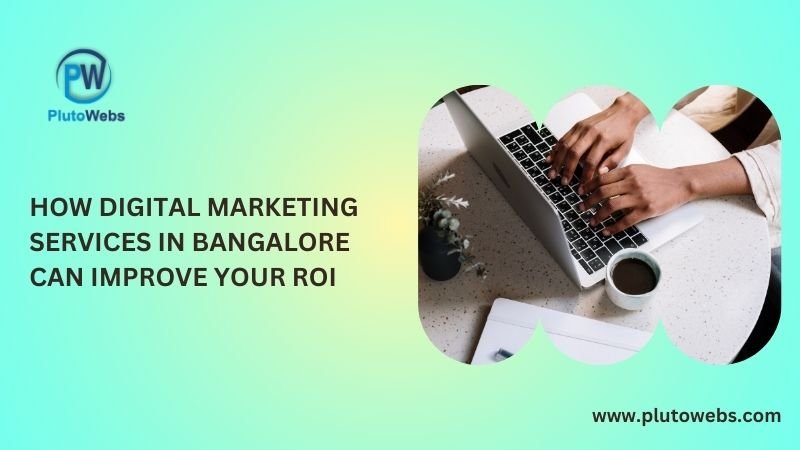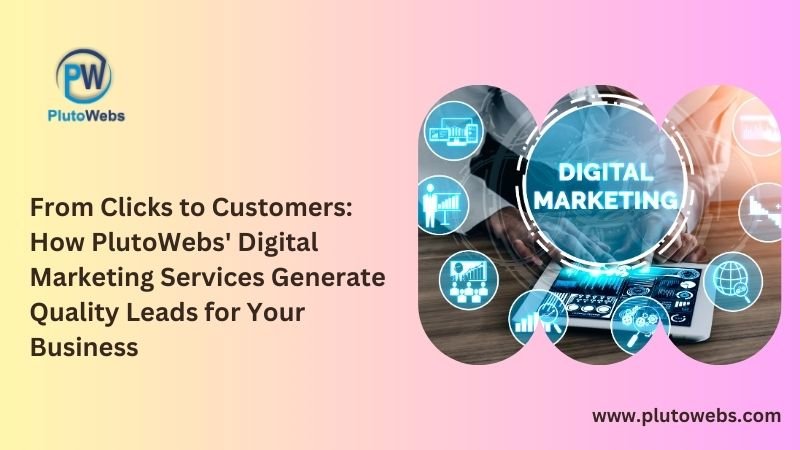Digital Marketing Strategies for Companies in Bangalore

In today’s digital-first world, companies in Bangalore need to implement effective digital marketing strategies to remain competitive in the dynamic market. As a thriving tech hub, Bangalore offers immense opportunities for businesses to expand their digital presence and reach a broader audience. Partnering with experienced firms like PlutoWebs can help businesses craft and execute comprehensive strategies for success. Understanding the Digital Landscape in Bangalore Bangalore is not just a technology capital but also a hotspot for diverse industries, including e-commerce, education, healthcare, and finance. This diversity demands tailored digital marketing strategies that cater to varying audience segments. Key Digital Marketing Strategies for Companies in Bangalore SEO plays a crucial role in enhancing a company’s online visibility. PlutoWebs specializes in optimizing websites to rank higher on search engines, ensuring businesses in Bangalore can attract organic traffic. Keyword optimization, quality content creation, and backlink strategies are essential components of effective SEO. PPC campaigns offer a direct way to drive targeted traffic. Bangalore-based businesses can leverage Google Ads and social media advertising to target specific demographics. PlutoWebs assists in creating data-driven PPC campaigns that maximize return on investment. Creating valuable and engaging content helps build brand authority and trust. Companies can benefit from blog posts, whitepapers, videos, and infographics to educate their audience. PlutoWebs helps craft content strategies that align with a company’s goals while optimizing for Bangalore’s competitive market. Social media platforms are essential for audience engagement and brand visibility. Companies in Bangalore can leverage platforms like Instagram, Facebook, and LinkedIn to promote their products and services. PlutoWebs ensures a consistent social media presence through scheduled posts, audience interaction, and performance analysis. Email marketing remains a cost-effective strategy for nurturing leads and maintaining customer relationships. Bangalore companies can use personalized email campaigns for product launches, special offers, and newsletters. PlutoWebs offers automated email marketing solutions to streamline communication. For businesses targeting local customers in Bangalore, local SEO is crucial. PlutoWebs assists in optimizing Google My Business profiles, gathering reviews, and implementing location-specific keywords to improve local search rankings. A well-designed website is the cornerstone of any digital marketing strategy. PlutoWebs specializes in creating responsive, user-friendly websites that not only attract visitors but also convert them into customers. Benefits of Implementing Effective Digital Marketing Strategies Increased Online Visibility: Proper SEO and content strategies help companies rank higher on search engines. Targeted Audience Reach: PPC and social media campaigns allow businesses to reach specific demographics. Higher Conversion Rates: Engaging content and optimized websites lead to better conversion rates. Enhanced Brand Credibility: Consistent online presence builds trust among potential customers. Why Choose PlutoWebs for Digital Marketing in Bangalore? PlutoWebs is a leading digital marketing agency in Bangalore, known for its expertise and results-driven approach. With a dedicated team of professionals, PlutoWebs offers customized strategies tailored to the unique needs of businesses in the region. Conclusion For companies in Bangalore, implementing effective digital marketing strategies is essential to staying competitive and driving growth. By partnering with experts like PlutoWebs, businesses can leverage tailored strategies that deliver measurable results. Whether it’s SEO, PPC, content marketing, or web design, a well-rounded approach can transform your online presence and help you achieve long-term success.
SEO Strategies Every Website Design Company in Bangalore Should Know

In today’s digitally driven world, where the majority of internet users access websites through their smartphones, having a mobile-optimized website is no longer a luxury but a necessity. For businesses in Bangalore, a city renowned for its vibrant tech ecosystem, partnering with expert service providers like PlutoWebs can make all the difference in achieving digital success. Why Mobile Optimization Matters With over 60% of global internet traffic coming from mobile devices, it is evident that users prefer accessing information on the go. Bangalore, being a hub of startups, corporates, and tech-savvy individuals, sees a significant percentage of its population relying on smartphones for their daily online activities. Without a mobile-friendly website, businesses risk losing a large chunk of potential customers. Mobile-optimized websites provide seamless navigation, faster loading times, and responsive designs. These features ensure users have a pleasant experience, which increases the likelihood of engagement and conversions. In a competitive market like Bangalore, where every second counts, a subpar user experience can drive users to competitors. Search engines like Google prioritize mobile-friendly websites. Google’s mobile-first indexing means that it predominantly uses the mobile version of a website for indexing and ranking. Companies that fail to adapt risk losing visibility on search engine results pages (SERPs). With PlutoWebs’ expertise in SEO-integrated web development, businesses in Bangalore can ensure their websites rank higher and attract more traffic. For businesses targeting local customers in Bangalore, mobile optimization is crucial for appearing in local search results. Many users perform “near me” searches on their smartphones to find nearby services or products. A mobile-optimized website ensures your business can tap into this local audience effectively. Challenges of Ignoring Mobile Optimization Neglecting mobile optimization can lead to several drawbacks, such as: Higher Bounce Rates: Users are likely to leave websites that are not mobile-friendly, leading to reduced engagement and lower conversion rates. Reduced Brand Credibility: A poorly designed website reflects negatively on a brand’s professionalism and reliability. Missed Revenue Opportunities: Without a mobile-friendly site, businesses miss out on capturing mobile shoppers, who form a significant portion of online consumers. Why Choose PlutoWebs for Mobile-Optimized Website Development in Bangalore? PlutoWebs specializes in creating responsive websites that adapt seamlessly to any device, ensuring optimal performance on smartphones, tablets, and desktops. Their team of skilled developers understands the nuances of designing for varied screen sizes and resolutions. A fast-loading website is critical for retaining users and reducing bounce rates. PlutoWebs employs advanced techniques such as image optimization, efficient coding, and content delivery network (CDN) integration to enhance website speed. Bangalore’s diverse business landscape demands tailored solutions. Whether you’re a tech startup, a retail store, or a service provider, PlutoWebs offers customized mobile optimization strategies that cater to your specific needs and goals. PlutoWebs incorporates SEO best practices into their development process. By optimizing mobile websites for keywords, meta tags, and local searches, they help businesses achieve better rankings and attract more targeted traffic. Recognizing the budget constraints of startups and small businesses, PlutoWebs offers affordable solutions without compromising on quality. Their scalable designs also ensure your website grows with your business. Success Stories of Mobile Optimization in Bangalore Numerous businesses in Bangalore have witnessed remarkable transformations after investing in mobile-optimized website development. From increased online visibility to enhanced customer satisfaction, the benefits are undeniable. PlutoWebs has played a pivotal role in driving these successes by delivering cutting-edge solutions that align with the latest industry trends. Conclusion As Bangalore continues to thrive as a global tech hub, businesses must prioritize mobile optimization to stay ahead in the competitive digital landscape. A mobile-optimized website not only improves user experience but also enhances SEO performance and boosts overall business growth. By partnering with experts like PlutoWebs, companies can unlock their full potential and cater effectively to the ever-growing mobile audience. If your business is looking to make a mark in Bangalore’s dynamic market, now is the time to invest in mobile-optimized website development services. With PlutoWebs by your side, achieving digital excellence is just a few clicks away.
How Digital Marketing Services in Bangalore Can Improve Your ROI

In today’s digitally driven world, where the majority of internet users access websites through their smartphones, having a mobile-optimized website is no longer a luxury but a necessity. For businesses in Bangalore, a city renowned for its vibrant tech ecosystem, partnering with expert service providers like PlutoWebs can make all the difference in achieving digital success. Why Mobile Optimization Matters With over 60% of global internet traffic coming from mobile devices, it is evident that users prefer accessing information on the go. Bangalore, being a hub of startups, corporates, and tech-savvy individuals, sees a significant percentage of its population relying on smartphones for their daily online activities. Without a mobile-friendly website, businesses risk losing a large chunk of potential customers. Mobile-optimized websites provide seamless navigation, faster loading times, and responsive designs. These features ensure users have a pleasant experience, which increases the likelihood of engagement and conversions. In a competitive market like Bangalore, where every second counts, a subpar user experience can drive users to competitors. Search engines like Google prioritize mobile-friendly websites. Google’s mobile-first indexing means that it predominantly uses the mobile version of a website for indexing and ranking. Companies that fail to adapt risk losing visibility on search engine results pages (SERPs). With PlutoWebs’ expertise in SEO-integrated web development, businesses in Bangalore can ensure their websites rank higher and attract more traffic. For businesses targeting local customers in Bangalore, mobile optimization is crucial for appearing in local search results. Many users perform “near me” searches on their smartphones to find nearby services or products. A mobile-optimized website ensures your business can tap into this local audience effectively. Challenges of Ignoring Mobile Optimization Neglecting mobile optimization can lead to several drawbacks, such as: Higher Bounce Rates: Users are likely to leave websites that are not mobile-friendly, leading to reduced engagement and lower conversion rates. Reduced Brand Credibility: A poorly designed website reflects negatively on a brand’s professionalism and reliability. Missed Revenue Opportunities: Without a mobile-friendly site, businesses miss out on capturing mobile shoppers, who form a significant portion of online consumers. Why Choose PlutoWebs for Mobile-Optimized Website Development in Bangalore? PlutoWebs specializes in creating responsive websites that adapt seamlessly to any device, ensuring optimal performance on smartphones, tablets, and desktops. Their team of skilled developers understands the nuances of designing for varied screen sizes and resolutions. A fast-loading website is critical for retaining users and reducing bounce rates. PlutoWebs employs advanced techniques such as image optimization, efficient coding, and content delivery network (CDN) integration to enhance website speed. Bangalore’s diverse business landscape demands tailored solutions. Whether you’re a tech startup, a retail store, or a service provider, PlutoWebs offers customized mobile optimization strategies that cater to your specific needs and goals. PlutoWebs incorporates SEO best practices into their development process. By optimizing mobile websites for keywords, meta tags, and local searches, they help businesses achieve better rankings and attract more targeted traffic. Recognizing the budget constraints of startups and small businesses, PlutoWebs offers affordable solutions without compromising on quality. Their scalable designs also ensure your website grows with your business. Success Stories of Mobile Optimization in Bangalore Numerous businesses in Bangalore have witnessed remarkable transformations after investing in mobile-optimized website development. From increased online visibility to enhanced customer satisfaction, the benefits are undeniable. PlutoWebs has played a pivotal role in driving these successes by delivering cutting-edge solutions that align with the latest industry trends. Conclusion As Bangalore continues to thrive as a global tech hub, businesses must prioritize mobile optimization to stay ahead in the competitive digital landscape. A mobile-optimized website not only improves user experience but also enhances SEO performance and boosts overall business growth. By partnering with experts like PlutoWebs, companies can unlock their full potential and cater effectively to the ever-growing mobile audience. If your business is looking to make a mark in Bangalore’s dynamic market, now is the time to invest in mobile-optimized website development services. With PlutoWebs by your side, achieving digital excellence is just a few clicks away.
How to Choose the Right Website Design Company in Bangalore for Your Brand

In today’s digital-first world, a professionally designed website is more than just a virtual storefront—it’s a cornerstone of your brand’s online presence. With Bangalore’s bustling tech ecosystem, the city is home to numerous website design companies that cater to businesses of all sizes. However, finding the right one for your brand can be a daunting task. Here are actionable tips to help you make an informed decision. Before diving into your search, take a moment to outline what you need from a website design company. Are you looking for a simple, informational site, an e-commerce platform, or a complex web application? Define your goals, target audience, and desired features. PlutoWebs always finds the right point for their clients and always chooses the following considerations. Key Considerations: What functionalities does your website need? What is your budget? What timeline are you working with? Begin by researching website design companies in Bangalore. Use search engines, local directories, and professional networks to create a list of potential agencies. Where to Look: Google searches (e.g., “Best website design companies in Bangalore”) Portfolios on platforms like Behance or Dribbble Reviews on Clutch, Google My Business, or Trustpilot A company’s portfolio speaks volumes about its capabilities. Look for projects similar to your requirements and assess their quality, creativity, and functionality. What to Check: User-friendly navigation and responsive design Aesthetics that align with your brand Successful implementation of client-specific features Client feedback provides insights into a company’s professionalism, communication skills, and ability to meet deadlines. Reach out to past clients if possible to get an unbiased perspective. Tip: Avoid companies with consistently poor reviews or lack of reviews altogether. Ensure the company is proficient in the latest technologies and design trends. They should also be well-versed in creating responsive designs optimized for all devices. Key Technologies to Look For: Front-end: HTML5, CSS3, JavaScript Back-end: PHP, Python, Node.js CMS Platforms: WordPress, Shopify, Drupal SEO and performance optimization techniques A visually appealing website is only half the battle won. Your website also needs to rank well on search engines. Choose a company that integrates SEO best practices into the design process. SEO Essentials: Fast loading speeds Mobile-friendly design Proper metadata and URL structures Cost is a crucial factor when choosing a website design company. Request detailed quotes and compare them against the scope of services offered. Questions to Ask: Are there any hidden fees? What is the payment schedule? Do they offer post-launch support? Strong communication ensures your vision is accurately translated into a functional website. Assess how responsive and transparent the company is during initial interactions. Post-launch Support:A good design company should offer ongoing maintenance, updates, and troubleshooting services. Bangalore-based companies have the advantage of understanding the local market. They can provide insights into regional user behavior and tailor your website accordingly. Time is money in business. Discuss the timeline for project completion to ensure it aligns with your goals. Questions to Clarify: How long will the design and development take? What happens if deadlines are missed? Conclusion Choosing the right website design company like PlutoWebs in Bangalore is a critical decision that can significantly impact your brand’s success. By understanding your requirements, researching thoroughly, and evaluating potential companies based on their portfolio, technical expertise, and communication skills, you can make a well-informed choice. Remember, the right partner will not just deliver a website but will create a platform that drives your business forward.
The Role of a Website Development Company in Bangalore in Scaling Your Business

In this article you will get to know what an important role a website development company in Bangalore plays to scale up your business
How a Digital Marketing Company in Bangalore Can Boost Your Business Growth

In today’s highly competitive market, having a robust online presence is no longer optional—it’s essential. Bangalore, known as the Silicon Valley of India, is home to a thriving digital marketing ecosystem. A well-established digital marketing company in Bangalore can provide tailored solutions to elevate your business and drive measurable growth. This article explores how partnering with a digital marketing agency in Bangalore can transform your business’s online visibility and revenue streams. Understanding the Role of Digital Marketing Digital marketing involves leveraging online platforms to promote a brand, product, or service. It encompasses strategies like search engine optimization (SEO), social media marketing, content creation, pay-per-click advertising, and email marketing. A professional digital marketing agency ensures that these strategies work cohesively to deliver maximum impact.If you’re in Bangalore, you have access to a pool of highly skilled professionals who understand both local and global market dynamics, making them well-equipped to deliver superior results. Benefits of Hiring a Digital Marketing Company in Bangalore 1. Expertise in Diverse StrategiesDigital marketing companies in Bangalore are renowned for their innovative approaches. They offer comprehensive solutions tailored to your business needs. Whether it’s creating SEO-friendly content or managing ad campaigns, these experts ensure your brand stands out. 2. Cost-Effective SolutionsHiring an in-house marketing team can be expensive. By outsourcing to a Bangalore-based agency, you gain access to top-tier professionals without the overhead costs. This allows businesses, especially startups and SMEs, to achieve significant results within a budget. 3. Local Market InsightsBeing a hub of technological advancements, Bangalore’s digital marketing agencies are well-versed in the nuances of the local market. They understand the target audience’s behavior, preferences, and purchasing patterns, helping your campaigns resonate better with your intended audience. 4. Advanced Tools and TechnologiesThe competitive landscape in Bangalore pushes digital marketing agencies to adopt the latest tools and technologies. From analytics platforms to AI-driven insights, these companies ensure your campaigns are data-driven and result-oriented.5. Measurable ResultsOne of the significant advantages of digital marketing is its measurability. Agencies in Bangalore provide detailed performance metrics for every campaign. This transparency allows Expertise in Diverse StrategiesDigital marketing companies in Bangalore are renowned for their innovative approaches. They offer comprehensive solutions tailored to your business needs. Whether it’s creating SEO-friendly content or managing ad campaigns, these experts ensure your brand stands out. 5. Cost-Effective SolutionsHiring an in-house marketing team can be expensive. By outsourcing to a Bangalore-based agency, you gain access to top-tier professionals without the overhead costs. This allows businesses, especially startups and SMEs, to achieve significant results within a budget. 6. Local Market InsightsBeing a hub of technological advancements, Bangalore’s digital marketing agencies are well-versed in the nuances of the local market. They understand the target audience’s behavior, preferences, and purchasing patterns, helping your campaigns resonate better with your intended audience. 7. Advanced Tools and TechnologiesThe competitive landscape in Bangalore pushes digital marketing agencies to adopt the latest tools and technologies. From analytics platforms to AI-driven insights, these companies ensure your campaigns are data-driven and result-oriented. 8.Measurable ResultsOne of the significant advantages of digital marketing is its measurability. Agencies in Bangalore provide detailed performance metrics for every campaign. This transparency allows you to track ROI and make informed decisions for future strategies. to track ROI and make informed decisions for future strategies. Key Services Offered by Digital Marketing Companies Search Engine Optimization (SEO)SEO is critical for driving organic traffic to your website. A digital marketing agency ensures your website ranks higher on search engine results pages (SERPs) for relevant keywords, increasing visibility and credibility. Social Media Marketing (SMM)Social platforms like Facebook, Instagram, and LinkedIn are powerful tools for engagement and brand awareness. Agencies craft tailored campaigns to build connections with your audience. Pay-Per-Click Advertising (PPC)For quick results, PPC campaigns are effective. With a focus on targeting the right audience, digital marketing agencies in Bangalore optimize ad spend to ensure high conversion rates. Content MarketingContent remains king in the digital space. Companies create compelling, SEO-optimized blogs, videos, and infographics that engage and educate your audience. Email MarketingEmail marketing campaigns deliver personalized messages to potential and existing customers, nurturing leads and encouraging repeat business. Conclusion A digital marketing company in Bangalore can be your growth catalyst. By combining local market insights, innovative strategies, and cutting-edge tools, they help your business achieve unparalleled online success. Whether you’re a small business or an established enterprise, investing in professional digital marketing services can significantly boost your bottom line.So, if you’re ready to scale new heights, consider partnering with a digital marketing company in Bangalore. It’s not just an investment in marketing—it’s an investment in your business’s future.
Top Features to Look for in Website Development Services in Bangalore

In this article readers will get a clear idea on what features a client expects from website development services in Bangalore
Why Interior Design Companies, Educational Institutes, and Nonprofits Need a Website to Thrive in a Digital World

In this article readers will learn that how websites makes easier for some companies to thrive this digital world
The Essential Guide to E-Commerce Websites: PlutoWebs’ Solutions for Boosting Your Online Sales

In this post you will get to know that in this fast paced world how E-Commerce business are making success.
From Clicks to Customers: How PlutoWebs’ Digital Marketing Services Generate Quality Leads for Your Business

In today’s hyper-competitive digital landscape, businesses are constantly seeking ways to stand out online and convert clicks into loyal customers. While traffic is essential, it’s the quality of leads that truly drives business growth. PlutoWebs, a leading digital marketing agency, steps in with its proven strategies for turning online visitors into high-converting leads. This article will explore how PlutoWebs’ digital marketing services help businesses generate valuable leads that translate into real, lasting customer relationships. 1. Data-Driven Targeting for Maximum ImpactEffective lead generation starts with targeting the right audience. Generic marketing strategies often fall short, as they cast a wide net without considering user intent or specific interests. PlutoWebs understands that not all clicks are created equal through data-driven insights and advanced analytics, PlutoWebs ensures that your marketing efforts are aimed directly at people who are most likely to convert into customers. By leveraging tools like Google Analytics, social media insights, and CRM data, PlutoWebs tailors each campaign to align with your ideal customer profile. Whether through pay-per-click (PPC) ads, socialmedia promotions, or organic search results, their strategies are designed to ensure that every click has the potential to bring in valuable leads.2. Search Engine Optimization (SEO) for Long-Term VisibilityGetting your website to rank on search engines like Google is essential for consistent traffic. However, the key to generating quality leads is ensuring that your website attracts not just any visitors, but those who are actively looking for your product or service. Search Engine Optimization (SEO) is crucial in driving organic traffic that is more likely to convert into customers. PlutoWebs offers comprehensive SEO services that go beyond just keyword optimization. Their approach includes on-page SEO, technical SEO, and off-page SEO, all aimed at improving your website’s visibility and authority. By crafting keyword-rich content, optimizing meta tags, and building high-quality backlinks, PlutoWebs boosts your website’s ranking in search engine results pages (SERPs), ensuring your businessreaches potential leads at the moment they are searching for solutions. 3. Paid Advertising (PPC) for Immediate ResultsWhile SEO is a long-term strategy, paid advertising provides immediate results. PlutoWebs excels at creating targeted PPC campaigns through platforms like Google Ads and Facebook Ads to drive traffic to your website. These campaigns focus on targeting specific user behaviors, such as searching for relevant keywords, or engaging with similar brands or products. With PPC, businesses only pay for actual clicks, making it a cost-effective way to drive traffic. PlutoWebs ensures that these ads are carefully crafted to attract visitors who are ready to convert. They optimizeeach campaign by adjusting ad copy, selecting the right keywords, and continually monitoring performance to improve results. This data-driven optimization helps ensure that each click brings in a potential lead, making PPC a powerful tool in your lead-generation strategy. 4. Compelling Content Marketing to Build Trust Content marketing plays a pivotal role in nurturing leads and establishing long-term relationships with potential customers. PlutoWebs understands that providing value through well-crafted content is essential for driving engagement and building trust. They create informative and engaging content such as blog posts, case studies, videos, and infographics that not only attract clicks but also educate and inspire visitors to take action. By aligning content with the needs and pain points of your target audience, PlutoWebs establishes your brand as an authority in your industry. This helps build a connection with potential customers, guiding them down the sales funnel from awareness to conversion. Whether it’s through a well-written blog post or an informative video, PlutoWebs’ content marketing strategies keep your audience engaged and motivated to become leads. 5. Social Media Marketing for Direct Engagement Social media is no longer just a platform for sharing photos and status updates—it’s a powerful tool for lead generation. PlutoWebs takes advantage of social media marketing to connect with potential customers where they already spend a significant amount of time. Through targeted ads and organic posts, PlutoWebs engages your audience with compelling content that encourages interaction and drives traffic back to your website. By leveraging platforms such as Facebook, Instagram, LinkedIn, and Twitter, PlutoWebs ensures thatyour business stays visible and top-of-mind for potential leads. Social media also offers valuable opportunities for retargeting—reaching users who have previously interacted with your brand, making it easier to nurture leads and bring them back to your website for conversion. 7. Lead Nurturing Through Email Marketing Once leads have shown interest, PlutoWebs uses email marketing to stay connected and guide them down the sales funnel. Through carefully crafted email sequences, they nurture leads with personalized content, promotions, and offers that keep your business top of mind and encourage futureconversions. Conclusion At PlutoWebs, the focus is on transforming clicks into loyal customers by employing a range of integrated digital marketing strategies. Through data-driven targeting, effective SEO, compelling content, social media marketing, and conversion optimization, PlutoWebs generates high-quality leads that help your business grow. If you’re ready to take your lead generation to the next level, PlutoWebs’ expertise can help turn your digital marketing efforts into a steady stream of customers. Reach out to PlutoWebs today and start converting clicks into customers!
